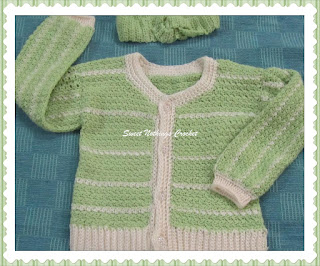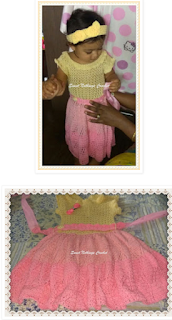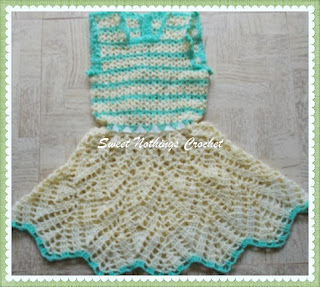Just yesterday I shared a cute little girls
dress and after I’d made that dress, I thought it could do with a little something more.. and this is what I’ve come up with.
For today's project I’ve used about 1.5 skeins of Oswal 4-ply acrylic yarn, with a 4 mm crochet hook
Pattern for the cute little girl's dress is here
Thank you for joining me.
In case you have just joined me, know that you can access all of my earlier creations by checking under ‘categories’ on the right hand side of this blog under “Labels”. Then, for your convenience, follow me here or on Facebook, You Tube, Pinterest, Twitter or Instagram.
Oh, and may I add that the fastest way to find any of my blogs is via Pinterest and for more children wear come here
All my blogs can be printed. Find the printer friendly (green) link on the right side of this blog. You can also hit Control P (or Command P for Mac) on your keyboard, and the blog will go directly to the connected printer.
Remember that you only print if absolutely essential. Save paper – Save Our Earth.
Do remember to add my blog URL when you make and show off your creation.
Just copy the link on the search bar above - that's the blog URL.
To purchase this or similar yarn online, click the highlighted links below to buy your yarns online via Amazon (India). While you will still pay the same, I may get paid by Amazon as well.
This is a free blog - so do pay it forward for me. Cheers.
Please remember that
as usual, I have lots of ideas and tweaks thrown in, so do read through all my
wordsy explanations. After all, I am
taking the trouble of thinking all this through 😆
And as we’re making requests, may I request you
to link my blog when you make your project. I feel horrid saying this, but there are many
who have used the patterns freely given here, and not given any credit to the
blog that has given them this pattern.
Come on guys.. it ain’t that much work to give credit and link the blog
now, is it?
It’s worse when someone says “taken this from
…(where ever they’ve taken the pattern from.. not just my blog I mean)” and not
taking the trouble of giving the proper link(s).
You got a free pattern ..
Pay It Forward ! Share away and add my blog link
Thanks for joining me once again as we work on
and discover this new pattern together.
General yarn info : The yarn used today is not specific to this pattern.
You can use any yarn with a suitable hook to make this project to any size.
International yarns : Among the international yarns I have used in this thickness, I’d suggest Aunt Lydia Cotton 10, Aunt Lydia Bamboo-Viscose 10, DMC Petra, Sullivans knitting cotton (Australia), Milford Soft, Hilaza Rustica Eclat , Alize cotton yarn and Alize bamboo yarn , Lily Sugar n' Cream cotton yarn, Caron Simply Soft , Bernat Softee chunky.
Size made : For
a 18 - 24 month old
Difficulty level
: Intermediate Skill level
Stitches used : Using U.S terminology
Here is a sizing chart for general neck sizing here or here Here is a sizing chart for general body sizing here , here or here
Abbreviations used : Using U.S terminology
ch : Chain sp(s) : Space(s)
dc : Double crochet hk : Hook
st(s) : Stitch(es) sl-st : slip stitch
sk : Skip sp : space
rep : repeat
fsc : Foundation single crochet
Instructions Using U.S terminology
Please note that I start all my rows with a ch 1, turning chain for ease.
Please check the top of this blog for easy video tutorials on all stitches used in today's pattern.
Please read through all my notes before you pick up your hook, so you know just where we're heading in our pattern.
In my patterns I work with the principle of stitch count and body measurement. This means that you need to work the stitch count in pattern, till you get the measurement (length and/or width) that you need for your project.
Inspired by a photo with its attached graph / chart , here are my pattern notes.
PART 1 : JACKET
In keeping with the pattern of the dress, I
thought I’d work in a plain-ish jacket and then add the shelled pattern for the
border trim.
So here are two ideas.. You could work the
pattern as I have OR you could work the shelled pattern all through. If you decide to work the shelled pattern,
you will just work the first fsc row in multiples of 7 and then work all
the way to the shoulders in a straight finish.
For the sleeves, I’d then suggest you work two rectangles that are about
the length of the arm, and neatly attach them at the shoulders.
However, I’m not doing that .. so come along and
let’s work this simple jacket together.
For the jacket I am going to work in one piece
for the fronts and back, and then add in the sleeves.
For the chest sizing, may I suggest you use this handy chart and start with foundation single crochet :
Start with as
many fsc as needed on the chart for the child you’re making this
for. Turn.
So what does this mean? Well, I’m making my
jacket for a 18-24 month old, so will use this chart and start with 66 fsc.
Now just for convenience, I will use
these numbers (66 fsc) to tell you how to work the corner pattern.. but this
does not mean you can’t use it for any other size. Use the idea here to
adapt it to your size with the numbers given for your size. Got it? Great.
Before we start on our next row, we will need to
mark off the four corners. So per my
chart for my size I will place markers at the 10th st ; then
count off 13 sts and place 2nd marker ; then count off 20 sts and
place 3rd marker ; finally count off 13 sts again for the final 4th
marker.
Double Crochet : dc : yo, insert hk into st ; yo (3 lps on hk);
[yo, draw through 2 lps] twice. One dc made.
Chainless start for Double Crochet : I dislike the ch-2 / ch – 3 start, and this is what I do to start my row of dc.
Row 1 : dc
in the 1st fsc and in each fsc till the 1st marker , 2 dc
in the marked fsc ; *ch 2, 2 dc in the next fsc ;
dc in each fsc till the next
marker, 2 dc in the marked fsc* ;
rep *to* all around till end ;
1 dc in the
last fsc. Turn.
You can now put your markers away, as the ch-2
sps in the corners will be your new corners.
Now once again its “Decision Time” as here are
ideas for the pattern of your jacket.
You can either work ch-sps every alternate row, OR you can work in all dc all
through. I am going to write it with the
ch-sp which is a tiny "leeetle" pattern that I like, but you go with your
creativity and flow.
If you decide not to do the ch-sp, then you just
ignore the sk st bit and work a dc in each st till the corners. Simple enough,
right?
Row 2 : dc
in the 1st 2 dc ;
*(ch 1, sk next dc, 2 dc in the next dc) ;
rep (to)
till the 1st corner sp ;
[dc ; ch 2, dc] in the corner sp* ;
rep *to*
all around dc in the last 2 dc. Turn.
Row 3 : dc
in the 1st 2 dc ;
*(dc in the next ch-1 sp ; dc in the next dc) ;
rep
(to) till the 1st corner sp ;
[dc ; ch 2, dc] in the corner sp* ;
rep *to* all around till the end.
Turn.
Rep Rows 2 & 3 till you have the yoke size
needed.
So calculations and how much is “needed”
:
After you’ve worked a few rows, you need to fold your work from the shoulders
down, and go back to the chart to see how many inches are suggested. In my case, I will work till my
shoulders are 7.75 cm and the length from shoulder to bottom of yoke is 10.5 cm
or so.
Now these are rough numbers and
you can decide how far down you need to work.
Remember though that you need to get the armhole measure, because
after a bit, we will join the two corners (each side)
and then work in one
continuous row from front to back ; around the back and then back to the front
again.
Just so you have an idea of how we’re going to
join the corners, take a quick look at this picture and see how we’re going to fold from the
shoulders, then Corners 1 & 2 will be joined at the corner ch-sp to get the
1st armhole ; and then Corners 3 & 4 will be joined at that
corner ch-sp to get the 2nd armhole.
So off you go and work your pattern rep of Rows
2 & 3 for the yoke size / armhole measure needed.
Now we have decisions again !
So you’re at the armhole level. You need to decide if you are going to work
the ch-sp pattern all the way down the jacket and into the arms.. OR you’re
going to work in each dc all the way through and have no pattern along the arms
either.
Either way, I will be working the little shelled
pattern at the ends of the sleeve and all along the bottom plus front plackets
of the jacket.
Secondly, joining at the armholes :
So as I said before Corners 1 & 2 will be
the 1st armhole.
So depending
on whether you are working the pattern or not, you will work in such a way that
you will join the two corners together and form an armhole opening for the 1st
armhole, then work the back through till Corners 3 & 4, which will be then
joined to form the 2nd armhole.
Once you’re done joining the armholes, and
decided if you’re using the pattern or not, all you need to do is continue
working in one continuous row from the front, around the back, and then to the
second part of the front till the front placket – till you have the jacket of
the length needed. Once you have the
length, fasten off and weave in ends.
SLEEVE IDEAS :
For the sleeve, you will re-attach your yarn at the bottom of the armhole, and
then work the pattern that you have worked for the jacket front &
back.
What length will you work for the sleeve?
We will be working four rows of the pattern for the end of the sleeve, so
measure how many inches make up your four rows, and you will work that much
less for the sleeve.
IF you are working this shelled pattern, then
you will also need to ensure that you have the stitch count in multiples of 7
For the shelled pattern border
work Rows 1 – 4 from the sleeve pattern.
IF you decide to work the picot ending, then you
will work Rows 1 – 3 of the Sleeve pattern and then Round 24 from the Skirt
pattern.
FRONT PLACKET & BACK OF NECK IDEAS : For the sleeve, you will re-attach
your yarn at the front bottom part of the placket and work in one continuous
movement for the placket and back of the neck.
Once again “Decision Time”. What pattern would you like to use? We have
two patterns for the edging. One is the
one you’ve just used for the belt and one you’ve used for the end of the
sleeve. So check the stitch count repeat
you need, and start on the pattern as per the instructions.
PART 2 : TURBAN HAT
For the next part of our creation, my client
chose this pattern, with this cute photograph that was so irresistible and cute
Please check the chart
here for head circumference as you work on your own hat.
PART 3 : HEADBAND & TIC-TACS
For the final part of our creation, let’s throw
in a few headwear pieces.
For the headband, go here
For the tic-tac clips, go here
Have a fun creative time.
Enjoyed this ?? I sure did.. come back right
here for more freebie patterns
If you're visiting me here for the first time,
and have liked the experience, do add me to your mailing list (for your
convenience) , and all my future free patterns will come straight to your mail
box.
I’d appreciate if you could credit my blog (and
link the original pattern link) when you make your own baby dress.
It
is quite sad that I have seen projects made using my pattern, but no
credit linked to my blog. It really does
not cost you to link my blog, but it pays me – appreciation and encouragement,
if nothing else… so go ahead, and do your bit, will you? Thanks.
If you're visiting me here for the first time, and have liked the experience, do add me to your mailing list (for your convenience) , and all my future free patterns will come straight to your mail box.
I’d appreciate if you could credit my blog (and link the original pattern link) when you make your own creation. Thanks.
Have a great day and see you soon.
I have a few girls dresses already made, and just
in case you want a dekho at those free patterns … here you go
Here are some of my bolero / vest / jacket creations...for kids and adults























































Great Blog
ReplyDelete